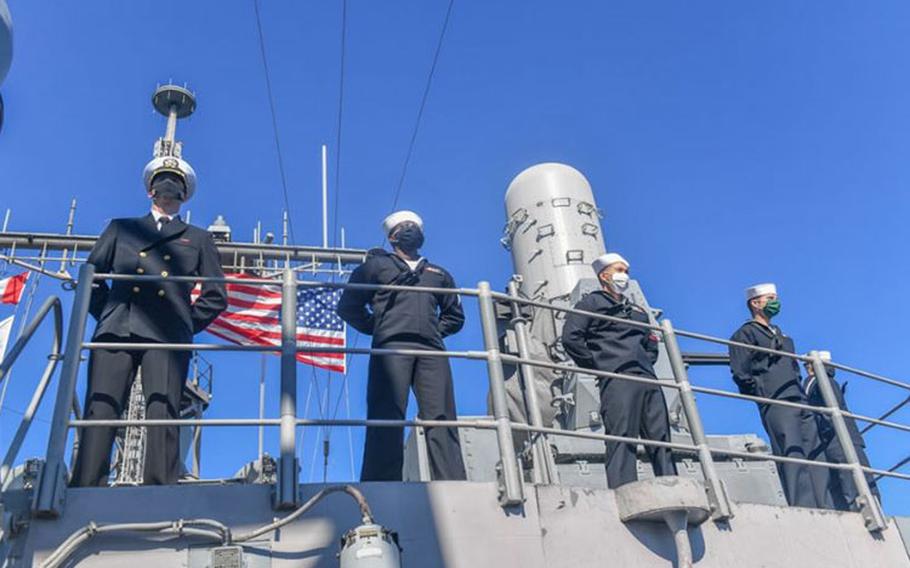Community News
USS Antietam returns to Yokosuka following 260-day deployment
Commander, U.S. 7th Fleet November 12, 2020

YOKOSUKA, Japan (Nov. 10, 2020) - Sailors man the rails as the Ticonderoga-class guided-missile cruiser USS Antietam (CG 54) returns to Yokosuka, Japan. Antietam’s return marked the end of a nine-month deployment in the U.S. 7th Fleet area of responsibility in support of security and stability in the Indo-Pacific. (Photo by Mass Communication Specialist 3rd Class James Hong) ()
YOKOSUKA, Japan – The crew of the Ticonderoga-class guided-missile cruiser USS Antietam (CG 54) returned to Naval Station Yokosuka following a successful deployment.
The return marked the end of a nine-month deployment to the U.S. 7th Fleet area of operations.
“Antietam’s success in this demanding operating environment and during deployment is attributed to my Sailors doing the right thing every day,” said Capt. Russell Caldwell, commanding officer, USS Antietam. “They never lost focus on the accomplishment of the mission.”
From May to October, Antietam escorted the Nimitz-class aircraft carrier USS Ronald Reagan (CVN 76) during a deployment in the U.S. 7th Fleet area of operations, including missions in the South China Sea, East China Sea and Indian Ocean, as well as dual carrier operations with the aircraft carrier USS Nimitz (CVN 68) and attached carrier strike group in July.
While assigned to the Reagan Strike Group in July, Antietam strengthened U.S. alliances through participation in a trilateral naval exercise with the Japan Maritime Self-Defense Force (JMSDF) and the Australian Defense Force in the Philippine Sea.
Antietam also participated in Valiant Shield in late September, a U.S. only, biennial field training exercise (FTX) with a focus on integration of joint training in a blue-water environment among U.S. forces. During the FTX, Antietam demonstrated their proficiencies in surface, subsurface and air warfare and tactics, and participated in a live-fire sinking exercise, targeting the ex-USS Curts (FFG 38), and a live-fire Tomahawk land attack cruise-missile (TLAM) strike scenario.
In October, Antietam capped off the rest of the deployment with independent operations in the East China Sea to support standing commitments to regional allies and partners.
Antietam traveled more than 60,000 nautical miles and conducted multiple sea lane and strait transits, to include the San Bernardino Archipelagic Sea Lane, Balabac Strait and the Strait of Malacca.
“For 260 days of COVID-free bubble operations, Antietam’s Sailors performed with honor, courage and commitment,” said Caldwell. “I cannot be more proud and it was my privilege to lead and serve alongside each and every one of them.”
In order to prevent the introduction of COVID-19 to the crew and maintain the ship’s combat readiness, the majority of Antietam’s crew, including embarked air detachment from Helicopter Maritime Strike Squadron (HSM) 77, remained aboard since their departure in late February. Several pier-restricted port visits were visited to facilitate crew rest amidst the deployment’s long periods at sea in support of operational tasking.
“Since we were already underway at the start [of the Pandemic], we set a lot of standards in preventing COVID-19 at sea,” said Hospital Corpsman 2nd Class Nico Watt, a member of Antietam’s medical staff. “We were the first to run an underway quarantine and MEDEVAC as a training scenario.”
Despite being “in the bubble”, Antietam’s Sailors conducted critical depot-level maintenance and repairs and passed multiple major inspections, including high scores on their Fleet Support Operations-Medical (FSO-M) and 3-M Program validation inspections.
USS Antietam is forward-deployed to the U.S. 7th Fleet area of operations in support of a free and open Indo-Pacific region. U.S. 7th Fleet is the largest numbered fleet in the world, and with the help of 35 other maritime-nation allies and partners, the U.S. Navy has operated in the Indo-Pacific region for more than 70 years, providing credible, ready forces to help preserve peace and prevent conflict.
For more information on USS Antietam and other forward-deployed ships in Japan, visit https://www.facebook.com/CTF70.